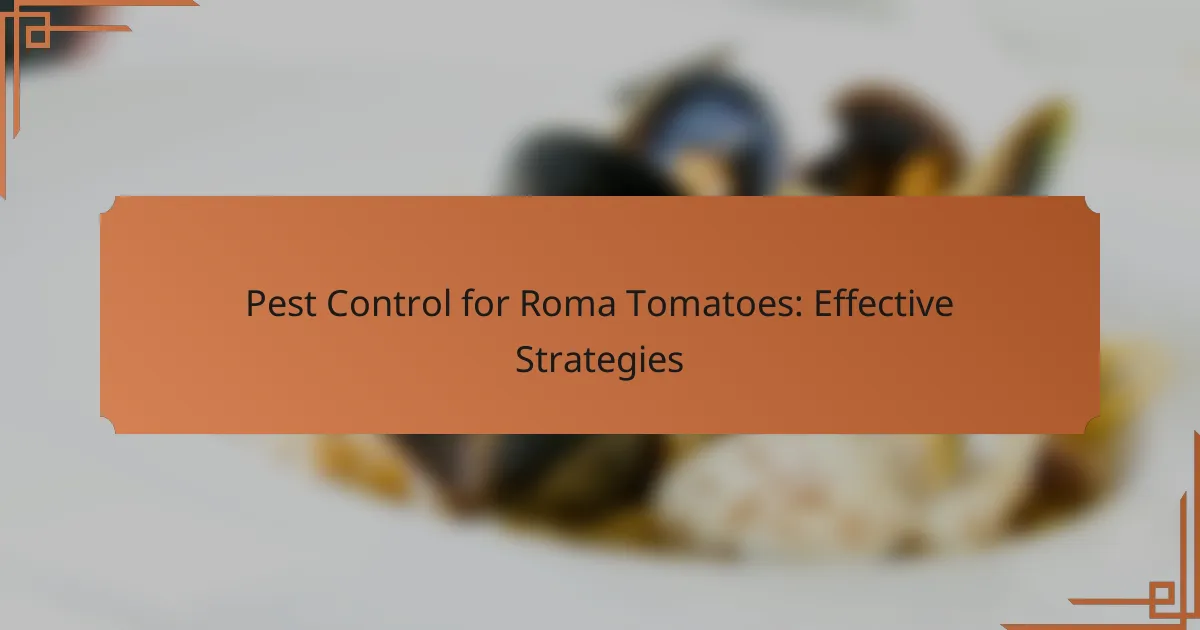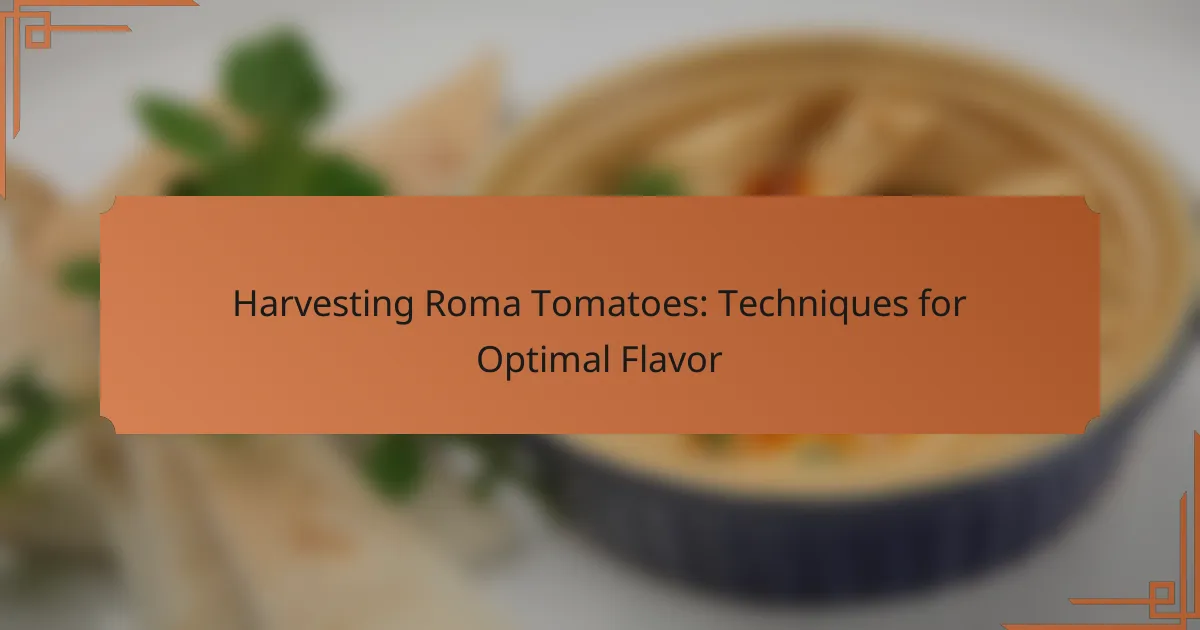Roma tomatoes are distinct in their nutritional profile, boasting higher levels of certain nutrients and lower calorie content compared to other varieties. Known for their rich vitamins, minerals, and antioxidants, they provide significant health benefits, making them a favored choice among health-conscious individuals. When compared to cherry, beefsteak, and heirloom tomatoes, Roma tomatoes stand out not only for their unique flavor and texture but also for their specific culinary applications.

How do Roma tomatoes compare nutritionally to other tomato varieties?
Roma tomatoes generally offer a unique nutritional profile that sets them apart from other tomato varieties. They are particularly known for their higher levels of certain nutrients and lower calorie content, making them a popular choice for health-conscious consumers.
Higher lycopene content
Roma tomatoes are recognized for their elevated lycopene levels, a powerful antioxidant linked to various health benefits, including reduced risk of certain cancers and heart disease. Compared to other varieties, such as cherry or beefsteak tomatoes, Roma tomatoes can contain significantly higher concentrations of this beneficial compound.
Incorporating Roma tomatoes into your diet can enhance your overall antioxidant intake. Consider using them in sauces or salads to maximize their lycopene benefits.
Lower calorie count
When it comes to calorie content, Roma tomatoes are typically lower than many other varieties. A medium Roma tomato contains about 30 calories, making them an excellent option for those looking to manage their weight. In contrast, larger varieties like beefsteak tomatoes can have nearly double the calorie count.
Choosing Roma tomatoes can help you maintain a low-calorie diet without sacrificing flavor. They are ideal for adding bulk to meals without significantly increasing caloric intake.
Rich in vitamins A and C
Roma tomatoes are a good source of vitamins A and C, both of which are essential for maintaining healthy skin, vision, and immune function. A medium Roma tomato can provide around 20% of the daily recommended intake for vitamin C and about 15% for vitamin A.
Including Roma tomatoes in your meals can help you meet your daily vitamin requirements. They can be easily added to salads, salsas, or cooked dishes to boost nutritional value.
Distinctive flavor profile
Roma tomatoes are known for their rich, slightly sweet flavor, which makes them a favorite for sauces and cooking. Their dense flesh and fewer seeds contribute to a more concentrated taste compared to juicier varieties like cherry tomatoes.
When selecting tomatoes for cooking, Roma tomatoes are often preferred for their ability to hold up well in sauces and stews. Their flavor enhances dishes without becoming overly watery.
Higher fiber content
Compared to other tomato varieties, Roma tomatoes tend to have a higher fiber content, which is beneficial for digestive health. A medium Roma tomato can provide about 1-2 grams of dietary fiber, aiding in regularity and satiety.
Incorporating Roma tomatoes into your diet can help increase your overall fiber intake. Use them in salads, sandwiches, or as a topping for whole-grain dishes to maximize fiber benefits.
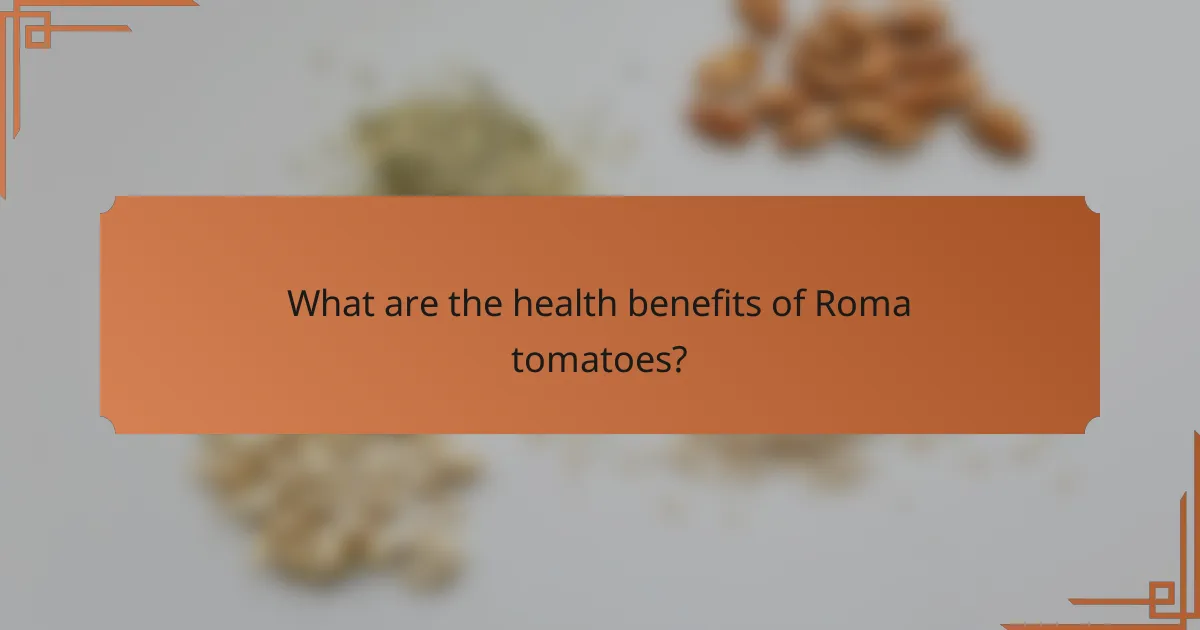
What are the health benefits of Roma tomatoes?
Roma tomatoes offer several health benefits, making them a nutritious addition to your diet. They are particularly rich in vitamins, minerals, and antioxidants, which contribute to overall well-being.
Supports heart health
Roma tomatoes are beneficial for heart health due to their high content of lycopene, a powerful antioxidant. Lycopene has been linked to lower cholesterol levels and reduced blood pressure, which can help prevent heart disease.
Incorporating Roma tomatoes into your meals can be simple; try adding them to salads, sauces, or as a topping on whole-grain bread. Aim for a few servings each week to maximize heart health benefits.
Aids in digestion
Rich in dietary fiber, Roma tomatoes can aid in digestion by promoting regular bowel movements and preventing constipation. Fiber helps maintain a healthy gut and supports the growth of beneficial gut bacteria.
To enhance digestive health, consider including Roma tomatoes in your diet regularly. Pair them with other fiber-rich foods like whole grains and legumes for a balanced approach.
Boosts immune system
Roma tomatoes are a good source of vitamins C and A, both of which play crucial roles in strengthening the immune system. Vitamin C helps protect against infections, while vitamin A supports skin and mucosal health, acting as a barrier to pathogens.
To boost your immune system, include Roma tomatoes in your meals, especially during cold and flu season. A simple tomato salad or a hearty tomato soup can provide a delicious way to enhance your nutrient intake.
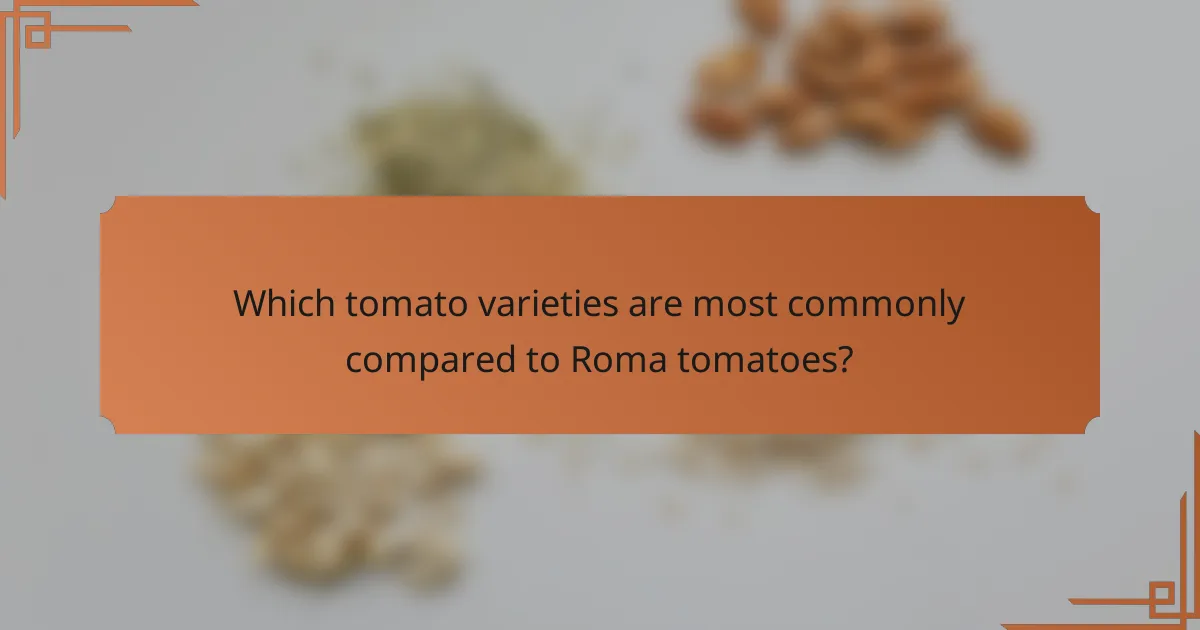
Which tomato varieties are most commonly compared to Roma tomatoes?
Roma tomatoes are often compared to cherry, beefsteak, and heirloom tomatoes due to their distinct characteristics and culinary uses. Each variety offers unique flavors, textures, and nutritional profiles that cater to different preferences and recipes.
Cherry tomatoes
Cherry tomatoes are small, round, and typically very sweet, making them a popular choice for salads and snacking. They contain slightly more sugar than Roma tomatoes, which contributes to their sweetness, but they generally have lower levels of certain nutrients like fiber and potassium.
When using cherry tomatoes in recipes, consider their juiciness and sweetness, which can enhance dishes like pasta or bruschetta. However, they may not provide the same meaty texture that Roma tomatoes offer in sauces and stews.
Beefsteak tomatoes
Beefsteak tomatoes are large, juicy, and known for their rich flavor, making them ideal for sandwiches and burgers. They have a higher water content compared to Roma tomatoes, which can make them less suitable for cooking down into sauces.
In terms of nutrition, beefsteak tomatoes have a similar vitamin C content but may have slightly fewer antioxidants than Roma tomatoes. If you prefer a fresh, juicy bite in your dishes, beefsteak tomatoes are a great option, but for thicker sauces, Roma tomatoes are preferable.
Heirloom tomatoes
Heirloom tomatoes come in various shapes, sizes, and colors, each with unique flavors and textures. They are often praised for their taste and are grown from seeds passed down through generations, which can result in a more complex flavor profile compared to Roma tomatoes.
Nutritionally, heirloom tomatoes can vary widely, but they often contain higher levels of antioxidants due to their diverse pigments. When choosing heirloom tomatoes, consider their intended use; they shine in fresh applications but may not substitute well for Roma tomatoes in cooked dishes due to their varying moisture content.
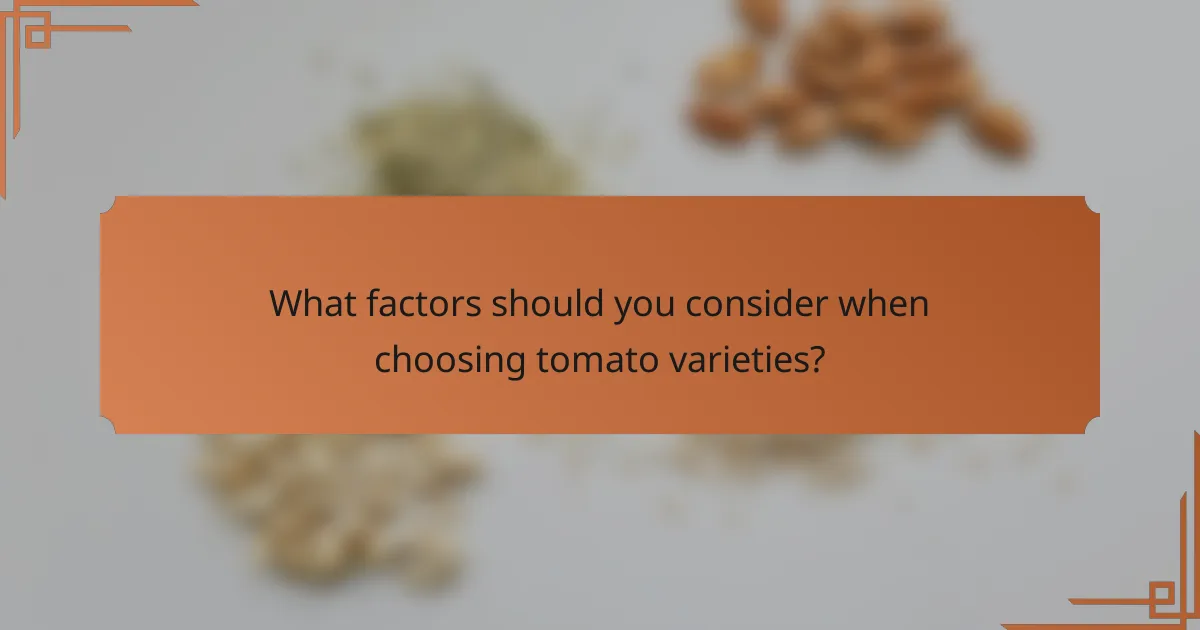
What factors should you consider when choosing tomato varieties?
When selecting tomato varieties, consider factors like flavor, culinary uses, and nutritional content. Each variety, including Roma tomatoes, offers unique characteristics that can influence your cooking and health choices.
Flavor preferences
Flavor is a key factor in choosing tomato varieties. Roma tomatoes are known for their rich, slightly sweet taste, making them ideal for sauces and pastes. In contrast, other varieties, such as beefsteak or cherry tomatoes, may offer a more robust or sweeter flavor, which can enhance salads or fresh dishes.
Consider your personal taste and the intended use of the tomatoes. If you prefer a tangy flavor, look for varieties like San Marzano, while those who enjoy a milder taste might opt for beefsteak tomatoes.
Culinary uses
Different tomato varieties excel in various culinary applications. Roma tomatoes are particularly suited for cooking due to their low moisture content and dense flesh, making them perfect for sauces, soups, and canning. Other varieties, such as heirloom tomatoes, are often enjoyed raw in salads or as garnishes because of their juiciness and vibrant colors.
When planning meals, think about how you will use the tomatoes. For instance, if you’re making a fresh salsa, cherry tomatoes might be preferable, while for a hearty marinara sauce, Roma tomatoes would be the better choice.
Nutritional needs
Nutritional content can vary among tomato varieties, impacting your dietary choices. Roma tomatoes are generally low in calories and rich in vitamins A and C, as well as antioxidants like lycopene, which may support heart health. Other varieties may have similar nutritional profiles but can differ in specific vitamin content or sugar levels.
To meet specific dietary needs, consider the nutritional benefits of each variety. For instance, if you are looking to increase your intake of vitamin C, opt for varieties like cherry tomatoes, which tend to have higher levels compared to Roma tomatoes.
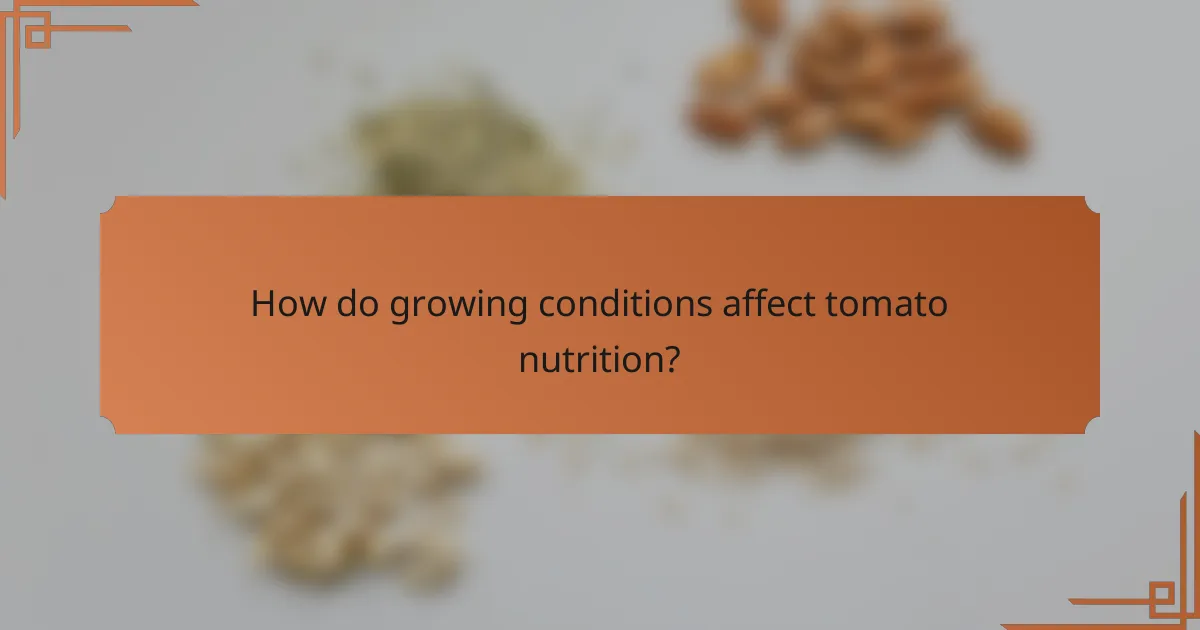
How do growing conditions affect tomato nutrition?
Growing conditions significantly influence the nutritional profile of tomatoes, including Roma varieties. Factors such as soil quality, climate, and water availability can enhance or diminish the levels of vitamins, minerals, and antioxidants in the fruit.
Soil quality impact
The quality of soil directly affects the nutrient uptake of tomato plants. Rich, well-draining soil with ample organic matter typically leads to healthier plants that produce more nutrient-dense fruit. Soil pH, which should ideally be between 6.0 and 6.8 for tomatoes, also plays a crucial role in nutrient availability.
For optimal growth, consider conducting a soil test to determine nutrient levels and pH. Adding compost or well-rotted manure can improve soil structure and fertility, enhancing the overall nutritional value of the tomatoes. Avoid using overly compacted or nutrient-poor soils, as they can lead to lower yields and less nutritious fruit.

